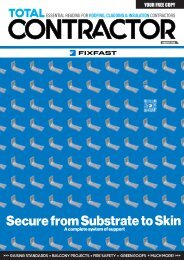Summer '22
Create successful ePaper yourself
Turn your PDF publications into a flip-book with our unique Google optimized e-Paper software.
Optigrun FKD 25 drainage board - for use on<br />
standard sedum roof system build-up.<br />
consequent root damage and potential<br />
failure of the vegetation. A good green<br />
roof system will provide this at different<br />
layers within the roof make up, one of<br />
which is within the drainage layers.<br />
The drainage layers on a vegetated<br />
green roof will typically consist of a<br />
protection fleece – unless the roof<br />
is of an inverted design – drainage<br />
and reservoir board and filter layer.<br />
With regard to the drainage and<br />
reservoir board, this will typically be<br />
manufactured from a recycled plastic,<br />
and it’s important that it has good<br />
reservoir function on its upper face with<br />
individual storage cells or chambers<br />
with overflow provision so that excess<br />
water can drain away below the board.<br />
The underside of the board should<br />
facilitate good drainage so that water<br />
cannot back up through the board and<br />
risk waterlogging of the substrate layer<br />
above. For example, at Optigrun we<br />
have different drainage and reservoir<br />
boards within our systems, ranging<br />
from 20mm to 60mm in depth, with<br />
different performance characteristics<br />
so that the correct product can be<br />
chosen for each project. The filter<br />
fleece that’s laid above it should have<br />
good mechanical filtration properties<br />
but also allow a sufficient rate of<br />
water flow. The current Green Roof<br />
Organisation (GRO) Green Roof Code<br />
(2021) sets out minimum performance<br />
characteristics for this layer.<br />
Pitched roofs<br />
Pitched green roofs are being specified<br />
in ever greater numbers and these<br />
present their own set of requirements<br />
when it comes to product selection. The<br />
general rule here is that it’s best not to<br />
improvise with the specification, but<br />
instead to use a system designed for<br />
the purpose. The “system approach”,<br />
mentioned previously, definitely<br />
applies where pitched green roofs are<br />
concerned.<br />
Generally, a pitched green roof is<br />
considered to be one that has a pitch<br />
in excess of 5 degrees. Beyond this<br />
figure the green roof specification will<br />
need to be completely different as the<br />
physics of the roof change. For example,<br />
transferred shear load and slippage risk<br />
have to be considered and the method<br />
of accommodating this will vary on<br />
each roof depending on, for example,<br />
pitch, slope length, waterproofing<br />
membrane being used and roof design<br />
– i.e., mono or duo pitch, perimeter<br />
detailing etc. The method of providing<br />
water storage and drainage will also<br />
change. I have surveyed several failed<br />
pitched green roofs in the past where<br />
an improvised anti-slip arrangement<br />
has been used, or in one case none at<br />
all, creating costly mistakes which could<br />
have been avoided if the correct system<br />
had been selected originally<br />
For pitched green roofs, therefore,<br />
a range of solutions is needed, and<br />
an engineered solution is required to<br />
provide a bespoke specification suited<br />
to the individual project.<br />
Substrate<br />
For the substrate or growing medium<br />
for a green roof, topsoil or recovered<br />
site spoil are not suitable products.<br />
Instead, a blended and engineered soil<br />
replacement should be used with a<br />
specified organic content. In this way<br />
the performance characteristics of the<br />
material, such as weight, water storage<br />
capacity, organic content and porosity<br />
are known.<br />
The GRO Green Roof Code sets out<br />
performance characteristics and also<br />
recommends that substrates selected<br />
Optigrun substrates are specifically<br />
engineered to provide the correct organic<br />
content needed for each green roof system.<br />
should have been tested according<br />
to BS 8616:2019 Specification for<br />
performance parameters and test<br />
methods for green roof substrates.<br />
Technical support<br />
Finally, it may seem obvious but make<br />
use of the technical services that<br />
your green roof supplier provides.<br />
They should be able to provide a<br />
bespoke specification for your project<br />
which should include technical data<br />
for the products included. If you are<br />
a contractor tendering for a green<br />
roof, this is particularly important as<br />
the specification that came with the<br />
enquiry may have been cut and pasted<br />
from a previous project and be entirely<br />
unsuitable for the project in hand.<br />
There is also useful independent advice<br />
available from GRO who are the body<br />
that represents the green roof industry<br />
in the UK. The latest edition of the<br />
Green Roof Code, introduced in 2021,<br />
and mentioned in this article, is full of<br />
useful information and design guidance<br />
for green roofs. You can download a<br />
free copy at:<br />
www.greenrooforganisation.org<br />
Contact<br />
Optigrun<br />
W: www.optigruen.com<br />
E: info@optigreen.co.uk<br />
T: 0207 5899 400<br />
www.greenscapemag.co.uk • GREENSCAPE SUMMER 2022 21

















